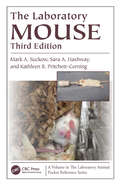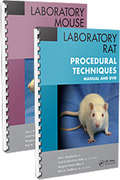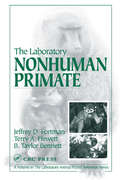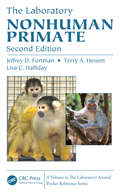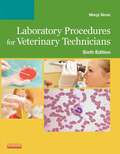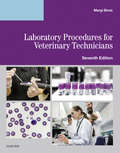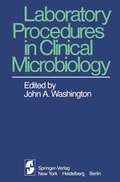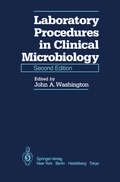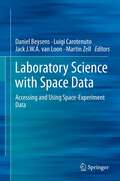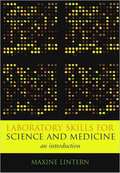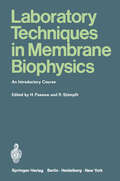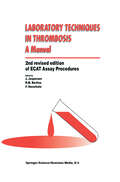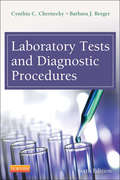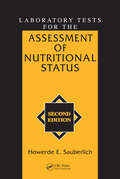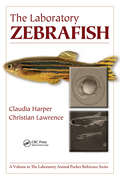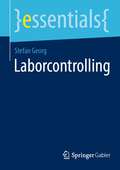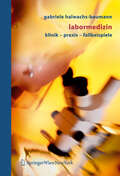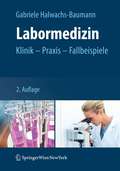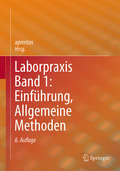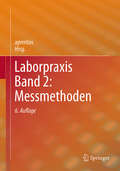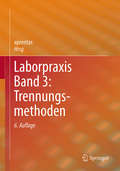- Table View
- List View
The Laboratory Mouse (Laboratory Animal Pocket Reference)
by Mark A. Suckow Sara Hashway Kathleen R. Pritchett-CorningWith the advent of transgenic and other genetic engineering technologies, the versatility and usefulness of the mouse as a model in biomedical research has soared. Revised to reflect advances since the second edition, The Laboratory Mouse continues to be the most accessible reference on the biology and care of the mouse in research settings. This guide presents basic information and common procedures in detail to provide a quick reference source for investigators, technicians, and caretakers on the humane care and use of the mouse. The new edition adds information on novel technologies such as CRISPR-Cas and on housing systems and management practices; it covers new concepts such as pain assessment by facial expression and the importance of nest-building as an assessment tool of well-being. There are now expanded sections on anesthesia and analgesia, and on behavior and enrichment. An ideal quick reference for investigators, technicians, and animal caretakers charged with the care and/or use of mice in a research setting, this book will be particularly valuable to those new to working with mice who need to start research programs using these animals.
Laboratory Mouse and Laboratory Rat Procedural Techniques: Manuals and DVDs
by John J. BogdanskeDespite the fact that the majority of research animals are rodents, the trainers at the Research Animal Resources Center at the University of Wisconsin-Madison found training material on the proper handling of mice and rats in biomedical research to be limited. So, they developed videos, narratives, pictures, and text to teach common handling, inje
The Laboratory Nonhuman Primate
by Jeffrey D. Fortman Terry A. Hewett Lisa C. HallidayDrawing on over 50 years of combined experience, The Laboratory Nonhuman Primate provides a quick reference source for technicians working with non-human primates in biomedical research. It details basic information and frequently used procedures such as duties of animal husbandry, facility management, regulatory compliance, and technical procedure
The Laboratory Nonhuman Primate (Laboratory Animal Pocket Reference)
by Jeffrey D. Fortman Terry A. Hewett Lisa C. HallidayKey features Contains 28 updated tables designed as quick, easy-to-use references for New and Old World species Provides over 100 photographs and illustrations, most now in color, depicting aspects of nonhuman primate biology, behavior, management practices, diseases, and technical procedures Gives a concise overview of regulatory considerations for the use of nonhuman primates in biomedical research Expands the Veterinary Care chapter to include new sections on nutritional support, behavioral conditions, dental care, and updated information on anesthetic and analgesic drugs Presents step-by-step descriptions of common and advanced sampling techniques Includes extensive resource lists for vendors of animals, feed, sanitation supplies, caging, anesthetic equipment, and veterinary and research supplies Extensively updated to include current literature, The Laboratory Nonhuman Primate, Second Edition, continues to serve as a quick reference source for technicians, caretakers, veterinarians, researchers, and students working with primates in biomedical research. It provides details on basic husbandry and covers biologic characteristics, regulatory compliance, common diseases, and anesthetic management.The text gives easy-to-follow descriptions of basic technical procedures including restraint, intubation, tuberculin skin testing, and collection of blood and urine samples. It also reviews advanced sampling procedures including collection of bone marrow, cerebrospinal fluid, bronchoalveolar lavage fluid, and rectal mucosal biopsy. The Laboratory Nonhuman Primate presents information in a clear, concise format to allow readers to incorporate concepts and techniques into the standard operating procedures of a facility.
The Laboratory Nonhuman Primate (Laboratory Animal Pocket Reference)
by Jeffrey D. Fortman Terry A. Hewett Lisa C. HallidayKey features Contains 28 updated tables designed as quick, easy-to-use references for New and Old World species Provides over 100 photographs and illustrations, most now in color, depicting aspects of nonhuman primate biology, behavior, management practices, diseases, and technical procedures Gives a concise overview of regulatory considerations for the use of nonhuman primates in biomedical research Expands the Veterinary Care chapter to include new sections on nutritional support, behavioral conditions, dental care, and updated information on anesthetic and analgesic drugs Presents step-by-step descriptions of common and advanced sampling techniques Includes extensive resource lists for vendors of animals, feed, sanitation supplies, caging, anesthetic equipment, and veterinary and research supplies Extensively updated to include current literature, The Laboratory Nonhuman Primate, Second Edition, continues to serve as a quick reference source for technicians, caretakers, veterinarians, researchers, and students working with primates in biomedical research. It provides details on basic husbandry and covers biologic characteristics, regulatory compliance, common diseases, and anesthetic management.The text gives easy-to-follow descriptions of basic technical procedures including restraint, intubation, tuberculin skin testing, and collection of blood and urine samples. It also reviews advanced sampling procedures including collection of bone marrow, cerebrospinal fluid, bronchoalveolar lavage fluid, and rectal mucosal biopsy. The Laboratory Nonhuman Primate presents information in a clear, concise format to allow readers to incorporate concepts and techniques into the standard operating procedures of a facility.
Laboratory Procedures for Veterinary Technicians - E-Book
by Margi SiroisNow in full color with hundreds of new images, Laboratory Procedures for Veterinary Technicians, 6th Edition covers the broad spectrum of laboratory procedures that veterinary technicians need to perform effectively in the practice setting. Comprehensive content presents the fundamentals of microbiology, hematology, urinalysis, immunology, and cytology, along with the laboratory procedures used to perform the most widely used tests such as complete blood count, urinalysis, and immunologic assays. This edition includes newly organized chapters with expanded coverage of essential material to prepare you for real-life laboratory work. "Everything you would expect from an in- house lab is listed here." Reviewed by Fabienne Dethioux on behalf of Vet Nurses Today, March 2015Comprehensive coverage gives you a solid foundation in the fundamentals of microbiology, hematology, urinalysis, immunology, and cytology, along with the laboratory procedures used to perform related tests.Step-by-step procedure boxes offer quick access to the skills you must perform during your educational program, as well as procedures that are commonly performed by vet techs in private practice.Provides the latest information needed to successfully perform a broad spectrum of laboratory tests, including complete blood count, urinalysis, and immunologic assays.Completely updated content throughout reflects the latest advances in veterinary clinical laboratory procedures for improved patient service and higher practice revenue.A comprehensive glossary of terms at the end of the text offers accurate, concise definitions and phonetic pronunciation guides.NEW! Streamlined chapters are shorter and easier to digest with expanded coverage of essential material to prepare you for real-life laboratory work.NEW! Full-color photos bring concepts to life, sequentially arranged to illustrate step-by-step procedures for all commonly performed diagnostic tests in the clinical laboratory.NEW! Companion Lab Manual (sold separately) includes multiple-choice questions, fill-in-the-blank exercises, photo quizzes, labeling exercises, crossword puzzles, and other activities to help you master and apply key concepts and procedures in clinical situations.NEW! Special emphasis on the significance of abnormal results of key lab tests, zoonoses, and hematology.NEW! Vet Tech Threads provide you with introductions, suggested readings, boxed technician notes, learning objectives, chapter outlines, key terms, and a glossary for easy navigation through chapters and more focused learning.
Laboratory Procedures for Veterinary Technicians E-Book
by Margi SiroisEnsure you’re at your clinical best! Laboratory Procedures for Veterinary Technicians, 7th Edition covers the broad spectrum of laboratory procedures that veterinary technicians need to perform effectively in the practice setting. Comprehensive content presents the fundamentals of microbiology, hematology, urinalysis, immunology, and cytology, along with the laboratory procedures used to perform the most widely used tests such as complete blood count, urinalysis, and immunologic assays. This thoroughly updated edition includes an expanded Quality Control and Record Keeping chapter along with the latest advances in veterinary clinical procedures to prepare you for real-life laboratory work.Comprehensive coverage gives you a solid foundation in the fundamentals of microbiology, hematology, urinalysis, immunology, and cytology, along with the laboratory procedures used to perform related tests.Provides the latest information needed to successfully perform a broad spectrum of laboratory tests, including complete blood count, urinalysis, and immunologic assays.Step-by-step procedure boxes offer quick access to the skills you must perform during your educational program, as well as procedures that are commonly performed by vet techs in private practice.A comprehensive glossary of terms at the end of the text offers accurate, concise definitions.Vet Tech Threads provide you with introductions, suggested readings, boxed technician notes, learning objectives, chapter outlines, key terms, and a glossary for easy navigation through chapters and more focused learning.NEW! Completely updated content throughout reflects the latest advances in veterinary clinical laboratory procedures for improved patient service and higher practice revenue.NEW! Thoroughly updated and expanded Quality Control and Record Keeping chapter ensures you have the most current information in this vital area. UPDATED! Immunology section includes the latest information in this fast-growing veterinary technology area.
Laboratory Procedures in Clinical Microbiology
by J. A. WashingtonAlthough there are a number of comprehensive books in clinical micro biology, there remains a need for a manual that can be used in the clinical laboratory to guide the daily performance of its work. Most of the existing publications provide detailed and precise information, for example, by which a microorganism can be characterized and identified beyond any doubt; however, the number of tests involved in this process exceeds the capabilities and resources of most clinical laboratories and are irrelevant for patient care. It is, therefore, necessary in any clinical laboratory to extract from reference manuals, textbooks, and journals those tests and procedures that are to be used to complete the daily workload !is efficiently and accurately as possible. It is also essential in the clinical laboratory to determine, on the basis of the kind of specimen being examined, which microorganisms are clinically relevant and require isolation and identifica tion and which should either be excluded selectively or simply regarded as indigenous Hora and, therefore, not specifically identified. Cost and time limit a laboratory's resources, and priorities must be established for handling the workload. The procedures described in this manual are those selected by our staff for use in the clinical laboratory on the basis of clinical relevance, accuracy, reproducibility, and efficiency. ' Alternative procedures, when considered equivalent on the basis of personal or published experience, have been in cluded where appropriate.
Laboratory Procedures in Clinical Microbiology
by J. A. WashingtonAlthough there are a number of comprehensive books in clinical micro biology, there remains a need for a manual that can be used in the clinical laboratory to guide the daily performance of its work. Most of the existing publications provide detailed and precise information, for example, by which a microorganism can be characterized and identified beyond any doubt; however, the number of tests involved in this process exceeds the capabilities and resources of most clinical laboratories and are irrele vant for patient care. It is, therefore, necessary in any clinical laboratory to extract from reference manuals, textbooks, and journals those tests and procedures that are to be used to complete the daily workload as efficiently and accurately as possible. It is also essential in the clinical laboratory to determine, on the basis of the kind of specimen being exam ined, which microorganisms are clinically relevant and require isolation and identification and which should either be excluded selectively or simply regarded as indigenous flora and, therefore, not specifically identi fied. Cost and time limit a laboratory's resources, and priorities must be established for handling the workload. The procedures described in the second edition of this manual are those selected by our staff for use in the clinical laboratory on the basis of clinic~l relevance, accuracy, reproducibility, and efficiency. Alternative procedures, when considered equivalent on the basis of personal or pub lished experience, have been included where appropriate.
Laboratory Science with Space Data: Accessing and Using Space-Experiment Data
by Daniel Beysens, Luigi Carotenuto, Jack J.W.A. J. W. A. van Loon and Martin ZellFor decades experiments conducted on space stations like MIR and the ISS have been gathering data in many fields of research in the natural sciences, medicine and engineering. The EU-sponsored Ulisse Internet Portal provides metadata from space experiments of all kinds and links to the data. Complementary to the portal, this book will serve as handbook listing space experiments by type of infrastructure, area of research in the life and physical sciences, data type, what their mission was, what kind of data they have collected and how one can access this data through Ulisse for further research.The book will provide an overview of the wealth of space experiment data that can be used for research, and will inspire academics (e.g. those looking for topics for their PhD thesis) and research departments in companies for their continued development.
Laboratory Skills for Science and Medicine: An Introduction
by Maxine Lintern Susan Greenfield Vern BarnetThis work contains a Foreword by Baroness Susan Greenfield, Director, Royal Institution of Great Britain, Fullerian Professor of Physiology, Senior Research Fellow Lincoln College and Honorary Fellow, St. Hilda's College, University of Oxford. This practical, concise and up-to-date guide is ideal as a quick reference. It is easy to read, refer to and comprehend - the perfect text to have on hand in the laboratory. "Laboratory Skills for Science and Medicine" contains useful equations, overviews of various techniques, and tips to help research run smoothly. Undergraduate and postgraduate students of science, medicine and biomedical science will find this manual invaluable, as will PhD candidates and researchers returning to laboratory work. 'Becoming a good biomedical researcher, like everything else in life, doesn't just happen overnight. Exploring your knowledge and skills base, and the gaps therein allows you to develop your approach to research in a systematic and productive manner. By taking advantage of the experience bundled into this volume, you are giving yourself the advantage of both an increased factual knowledge and useful practical applications which will help you on the road to achieving your goals, whether that is a good first degree, your first publication, that first grant or a Noble prize! If you want to give yourself a flying start in your lab career, then this book is for you.' - Maxine Lintern, in the Introduction.
Laboratory Skills for Science and Medicine: An Introduction
by Maxine Lintern Susan Greenfield Vern BarnetThis work contains a Foreword by Baroness Susan Greenfield, Director, Royal Institution of Great Britain, Fullerian Professor of Physiology, Senior Research Fellow Lincoln College and Honorary Fellow, St. Hilda's College, University of Oxford. This practical, concise and up-to-date guide is ideal as a quick reference. It is easy to read, refer to and comprehend - the perfect text to have on hand in the laboratory. "Laboratory Skills for Science and Medicine" contains useful equations, overviews of various techniques, and tips to help research run smoothly. Undergraduate and postgraduate students of science, medicine and biomedical science will find this manual invaluable, as will PhD candidates and researchers returning to laboratory work. 'Becoming a good biomedical researcher, like everything else in life, doesn't just happen overnight. Exploring your knowledge and skills base, and the gaps therein allows you to develop your approach to research in a systematic and productive manner. By taking advantage of the experience bundled into this volume, you are giving yourself the advantage of both an increased factual knowledge and useful practical applications which will help you on the road to achieving your goals, whether that is a good first degree, your first publication, that first grant or a Noble prize! If you want to give yourself a flying start in your lab career, then this book is for you.' - Maxine Lintern, in the Introduction.
Laboratory Techniques in Membrane Biophysics: An Introductory Course
by Heinz Passow Robert StämpfliThe present manual contains a collection of laboratory instructions used during an international training course on membrane biophysics which was held at Homburg in the fall of 1966. The selection of the topics dealt with in the various chapters depended on the scientific interest of the available teachers and on the availability of the necessary equipment in our laboratories. Thus, the material included in this volume does not add up to a systematic course in membrane biophysics. Instead it represents a more fortuitous collection of laboratory problems. In addition, some authors place more emphasis on teaching the more technical aspects of a method whereas others are primarily concerned with the demonstra tion of a significant biological phenomenon. Nevertheless, in spite of such differences of emphasis and a somewhat haphazard choice of a few methods and phenomena among many others of similar importance, it was felt that the publication of the material is desirable. Since no other laboratory manual exists so far, the present laboratory problems which were tested in actual practice may serve as a useful basis for the shaping of further training courses or for laboratory courses for graduate students in biophysics and physiology. Our thanks are due to the authors and the publisher who were patient and kind enough to cooperate with the editors during the long period between the end of the course and the appearance of the book.
Laboratory Techniques in Thrombosis — a Manual
by F. Haverkate R. M. Bertina J. JespersenThe first edition of this manual appeared in 1992 and was entitled ECAT Assay Procedures. It was the result of a unique cooperation between experts brought together by the European Concerted Action on Thrombosis and Disabilities (ECAT). The Concerted Action was at that time under the auspices of the Commission of the European Union. The second edition, like the first edition, deals with diagnostic tests within the field of thrombosis. However, the second edition has a broader scope because it is no longer limited by the frontiers of ECAT. Experts allover the world, in and outside ECAT, have contributed to this edition. The editors are very grateful for their contributions. The need for a new edition is obvious. Since 1992 new assays have been introduced for research, diagnosis, and therapy of thrombosis; for other assays improvements have been suggested, while a few others became redundant. The editors waived the radioimmunoassays of ~-thrombog1obulin and platelet factor 4 due to the fact that the kits required for these assays are rarely, or no longer, available. Also the PAI-1 activity assay was waived as it is liable to many inconsistencies and to large variations. A list of names and addresses of manufacturers marketing the kits and reagents has been compiled, together with a list of the recommended nomenclature of quantities in thrombosis and haemostasis, in order to facilitate the use of the updated version. These lists have been carefully compiled by Johannes J. Sidelmann, PhD, Department of Clinical Biochemistry in Esbjerg, Denmark.
Laboratory Tests and Diagnostic Procedures - E-Book
by Cynthia C. Chernecky Barbara J. BergerFind complete answers to questions such as which laboratory tests to order or what the results might mean. Laboratory Tests and Diagnostic Procedures, 6th Edition covers more tests than any other reference of its kind, with over 900 lab tests and diagnostic procedures in all. In Part I, you'll find an alphabetical list of hundreds of diseases, conditions, and symptoms, including the tests and procedures most commonly used to confirm or rule out a suspected diagnosis. In Part II, you’ll find descriptions of virtually every laboratory and diagnostic test available. This edition is updated with the latest research and over 20 NEW test entries. Written by educator Cynthia Chernecky and clinical nurse specialist Barbara Berger, this lab reference covers today’s lab tests with concise, easy-to-use information. More than 900 laboratory tests and diagnostic procedures are included — more than any other reference!Over 600 diseases, conditions, and symptoms are listed, along with the tests used to confirm them.Alphabetical organization and A-to-Z thumb tabs make it easy to find the information you’re looking for.Alternative test names and acronyms are cross-referenced to simplify lookup.Instructions for client and family teaching help you offer guidance concerning test preparation and follow-up care.Age and gender-specific norms are provided, giving you complete lifespan coverage.Risks and Contraindications are highlighted to help you safeguard your patients and provide effective care.Panic Level Symptoms and Treatment are provided for dangerously increased and decreased levels. Minimum volumes for blood samples are included, useful when a client’s blood preservation is essential, as well as information on whether blood specimens can be drawn during hemodialysis.Tests for toxic substances are included, making this a lab, diagnostic, and toxicology book all in one.Abbreviations, measurement prefixes, and symbols are listed on the front and back covers for convenience. Information on herbal supplements indicates when a client’s use of natural remedies might affect test results. Over 20 NEW test entries present the latest tests and procedures, with a strong focus on affordable, clinically relevant genetic tests. UPDATED content includes the latest research relating to accuracy of tests, diagnostic value of results, and associated cost-benefit ratios.
Laboratory Tests for the Assessment of Nutritional Status
by Howerde E. SauberlichProper nutrition is the single most important component of preventative health care. Heart disease, diabetes, and other ailments are all linked to dietary habits. Accurate nutritional assessment can be a matter of life or death. Laboratory Tests for the Assessment of Nutritional Status explores the expanded number of nutrients that can now be evaluated. The author makes a compelling case for the practice and advancement of this critical health care tool. Nutritional assessment identifies undernutrition, overnutrition, specific nutrition deficiencies, and imbalances. Diligent assessment determines the appropriate nutrition intervention and monitors its effects. This book is a total revision of the 1974 version of the same title co -authored by Sauberlich. Since then, remarkable progress has been made on the methodologies applicable to nutrition status assessment and to the expanded number of nutrients that can be evaluated, especially trace elements. The introduction of high-performance liquid chromatography, amperometric detectors, and other technologies has advanced nutritional assessment by leaps and bounds. Today, nutritionists can gauge the value of microminerals, trace elements, and ultratrace elements. Sauberlich's revision updates the reader to the latest and most important trends in nutrition. These laboratory methods for the assessment of nutritional status are vital for identifying individuals as well as populations with nutritional risks.
Laboratory Tests for the Assessment of Nutritional Status (Modern Nutrition Ser. #21)
by Howerde E. SauberlichProper nutrition is the single most important component of preventative health care. Heart disease, diabetes, and other ailments are all linked to dietary habits. Accurate nutritional assessment can be a matter of life or death. Laboratory Tests for the Assessment of Nutritional Status explores the expanded number of nutrients that can now be evaluated. The author makes a compelling case for the practice and advancement of this critical health care tool. Nutritional assessment identifies undernutrition, overnutrition, specific nutrition deficiencies, and imbalances. Diligent assessment determines the appropriate nutrition intervention and monitors its effects. This book is a total revision of the 1974 version of the same title co -authored by Sauberlich. Since then, remarkable progress has been made on the methodologies applicable to nutrition status assessment and to the expanded number of nutrients that can be evaluated, especially trace elements. The introduction of high-performance liquid chromatography, amperometric detectors, and other technologies has advanced nutritional assessment by leaps and bounds. Today, nutritionists can gauge the value of microminerals, trace elements, and ultratrace elements. Sauberlich's revision updates the reader to the latest and most important trends in nutrition. These laboratory methods for the assessment of nutritional status are vital for identifying individuals as well as populations with nutritional risks.
The Laboratory Zebrafish (Laboratory Animal Pocket Reference)
by Claudia Harper Christian LawrenceLike other books in the Laboratory Animal Pocket Reference Series, this guide covers all aspects pertaining to the use of these organisms including their basic biology, humane care and management, husbandry, life support systems, regulatory compliance, technical procedures, veterinary care, and water quality management. In the relatively brief span
The Laboratory Zebrafish (Laboratory Animal Pocket Reference)
by Claudia Harper Christian LawrenceLike other books in the Laboratory Animal Pocket Reference Series, this guide covers all aspects pertaining to the use of these organisms including their basic biology, humane care and management, husbandry, life support systems, regulatory compliance, technical procedures, veterinary care, and water quality management. In the relatively brief span
Laborcontrolling (essentials)
by Stefan GeorgUnternehmen wollen und müssen Geld verdienen. Zur Erreichung dieses Ziels muss jede Fachabteilung beitragen – auch das Labor. Gerade in Laboren arbeiten viele Fachkräfte ohne kaufmännische Erfahrung. An diese richtet sich das Buch.Lernen Sie die wichtigen Grundlagen des Rechnungswesens kennen, auf Basis derer Gewinne und Rentabilitäten bestimmt werden. Auch typische kostenrechnerische Werkzeuge wie der Betriebsabrechnungsbogen oder die Deckungsbeitragsrechnung werden thematisiert. Erfahren Sie, wie Sie Kennzahlen zur Unternehmenssteuerung richtig einsetzen können, was Sie dabei beachten müssen und welche laborspezifischen Kennzahlen es gibt. Und machen Sie sich ein Bild davon, wie Sie mit einer Balanced Scorecard das Labor (und das gesamte Unternehmen) zielgerichtet steuern können.Alle dargestellten betriebswirtschaftlichen Methoden sind grundlegend beschrieben und auf die Besonderheiten des Labors übertragen.
Labormedizin: Klinik – Praxis – Fallbeispiele
by Gabriele Halwachs-BaumannDie labormedizinische Diagnostik ist neben den bildgebenden Verfahren die wichtigste Hilfsdisziplin im medizinischen Alltag. Keine medizinische Fachrichtung kommt ohne sie aus. Durch die Automatisierung und die Einführung neuer Methoden und neuer Parameter ist es in den letzten Jahrzehnten zu einem rapiden Anstieg von labormedizinischen Daten und Befunden gekommen, die täglich produziert werden. In diesem Lehrbuch wird praxisorientiert und an Hand von Fallbeispielen die Interpretation von Laborbefunden, der sinnvolle Einsatz und die unterschiedliche Aussagekraft einzelner Werte erläutert. Die Gliederung in klinische Fragestellungen wie kardiale Labordiagnostik, hepatologische Labordiagnostik, etc. gibt einen raschen Überblick über relevante Parameter und erleichtert eine zielgerichtete Anforderung von Laborparametern im klinischen Alltag. Das Buch bietet eine praktische Einführung für Medizinstudenten und Ärzte in Ausbildung sowie für Personen, die im medizinisch-diagnostisch Bereich tätig sind.
Labormedizin: Klinik – Praxis – Fallbeispiele
by Gabriele Halwachs-BaumannDurch die Automatisierung und die Einführung neuer Methoden und Parameter ist es in den letzten Jahrzehnten zu einem rapiden Anstieg labormedizinischer Daten gekommen. In dem Lehrbuch wird praxisnah und anhand von Fallbeispielen erläutert, wie Laborbefunde zu interpretieren sind und welche Aussagekraft einzelne Werte haben. Dabei erlaubt die Gliederung in klinische Fragestellungen einen raschen Überblick über relevante Parameter. Die 2. Auflage berücksichtigt internationale Richtlinien, neue wissenschaftliche Erkenntnisse wurden eingearbeitet.
Laborpraxis Band 1: Einführung, Allgemeine Methoden
by AprentasDas vierbändige Standardwerk für die grundlegende praktische Arbeit im chemisch-pharmazeutischen Labor mit Schwerpunkt Synthesemethoden, Chromatographie und Spektroskopie liegt jetzt in der 6. völlig neu überarbeiteten Auflage vor. Es dient Berufseinsteigern als breit angelegtes Lehrmittel und erfahrenen Fachkräften als Nachschlagewerk mit übersichtlich dargestellten theoretischen Grundlagen und konkreten, erprobten Anwendungsideen. Die theoretischen Grundlagen für jedes Kapitel sind gut lesbar abgefasst und unterstützen das Verständnis für praktische Arbeiten und Gerätefunktionen. Zu jedem Kapitel gibt es Hinweise auf vertiefende und weiterführende Literatur. Arbeitssicherheit und –hygiene sowie die zwölf Prinzipien der nachhaltigen Chemie finden neben den entsprechenden Kapiteln Beachtung. Die im Buch erwähnten praktischen Grundlagen gründen auf Gegebenheiten in der chemisch-pharmazeutischen Industrie in der Schweiz. Sie finden im gesamten deutschsprachigen Raum Anwendung, auch in verwandten Arbeitsgebieten wie biochemischen, klinischen, werkstoffkundlichen oder universitären Laboratorien. Die Laborpraxis eignet sich für den Einsatz in der Grund- und in der Weiterbildung von Fachpersonal. Der Inhalt entspricht den aktuellen Anforderungen der Bildungsverordnung und des Bildungsplanes zum Beruf Laborantin / Laborant mit eidgenössischem Fähigkeitszeugnis (EFZ), welche vom Staatssekretariat für Bildung, Forschung und Innovation (SBFI) in Bern verordnet wurden. Damit steht den Lernenden eine gute Grundlage für die Vorbereitung auf das Qualifikationsverfahren (QV) zur Verfügung; Expertinnen und Experten stützen ihre persönlichen Vorbereitungsarbeiten und ihre fachlichen Beurteilungen auf dieses Buch. Band 1 und Band 2 behandeln ausführlich die Grundlagen der Laborarbeit und ausgewählte Messtechniken. Band 3 ist auf präparative und analytische Trennungsmethoden, Band 4 auf nasschemische und spektroskopische Analysemethoden fokussiert. Sowohl konventionelle Methoden als auch modernste Techniken finden Erwähnung. Der Fokus auf beständig gültigen Prinzipien erlaubt auch neue, nicht erwähnte Techniktrends zu verstehen sowie die tägliche Arbeit im chemisch-pharmazeutischen Labor zu reflektieren.
Laborpraxis Band 2: Messmethoden
by AprentasDas vierbändige Standardwerk für die grundlegende praktische Arbeit im chemisch-pharmazeutischen Labor mit Schwerpunkt Synthesemethoden, Chromatographie und Spektroskopie liegt jetzt in der 6. völlig neu überarbeiteten Auflage vor. Es dient Berufseinsteigern als breit angelegtes Lehrmittel und erfahrenen Fachkräften als Nachschlagewerk mit übersichtlich dargestellten theoretischen Grundlagen und konkreten, erprobten Anwendungsideen. Die theoretischen Grundlagen für jedes Kapitel sind gut lesbar abgefasst und unterstützen das Verständnis für praktische Arbeiten und Gerätefunktionen. Zu jedem Kapitel gibt es Hinweise auf vertiefende und weiterführende Literatur. Arbeitssicherheit und –hygiene sowie die zwölf Prinzipien der nachhaltigen Chemie finden neben den entsprechenden Kapiteln Beachtung. Die im Buch erwähnten praktischen Grundlagen gründen auf Gegebenheiten in der chemisch-pharmazeutischen Industrie in der Schweiz. Sie finden im gesamten deutschsprachigen Raum Anwendung, auch in verwandten Arbeitsgebieten wie biochemischen, klinischen, werkstoffkundlichen oder universitären Laboratorien. Die Laborpraxis eignet sich für den Einsatz in der Grund- und in der Weiterbildung von Fachpersonal. Der Inhalt entspricht den aktuellen Anforderungen der Bildungsverordnung und des Bildungsplanes zum Beruf Laborantin / Laborant mit eidgenössischem Fähigkeitszeugnis (EFZ), welche vom Staatssekretariat für Bildung, Forschung und Innovation (SBFI) in Bern verordnet wurden. Damit steht den Lernenden eine gute Grundlage für die Vorbereitung auf das Qualifikationsverfahren (QV) zur Verfügung; Expertinnen und Experten stützen ihre persönlichen Vorbereitungsarbeiten und ihre fachlichen Beurteilungen auf dieses Buch. Band 1 und Band 2 behandeln ausführlich die Grundlagen der Laborarbeit und ausgewählte Messtechniken. Band 3 ist auf präparative und analytische Trennungsmethoden, Band 4 auf nasschemische und spektroskopische Analysemethoden fokussiert. Sowohl konventionelle Methoden als auch modernste Techniken finden Erwähnung. Der Fokus auf beständig gültigen Prinzipien erlaubt auch neue, nicht erwähnte Techniktrends zu verstehen sowie die tägliche Arbeit im chemisch-pharmazeutischen Labor zu reflektieren.
Laborpraxis Band 3: Trennungsmethoden
by AprentasDas vierbändige Standardwerk für die grundlegende praktische Arbeit im chemisch-pharmazeutischen Labor mit Schwerpunkt Synthesemethoden, Chromatographie und Spektroskopie liegt jetzt in der 6. völlig neu überarbeiteten Auflage vor. Es dient Berufseinsteigern als breit angelegtes Lehrmittel und erfahrenen Fachkräften als Nachschlagewerk mit übersichtlich dargestellten theoretischen Grundlagen und konkreten, erprobten Anwendungsideen. Die theoretischen Grundlagen für jedes Kapitel sind gut lesbar abgefasst und unterstützen das Verständnis für praktische Arbeiten und Gerätefunktionen. Zu jedem Kapitel gibt es Hinweise auf vertiefende und weiterführende Literatur. Arbeitssicherheit und –hygiene sowie die zwölf Prinzipien der nachhaltigen Chemie finden neben den entsprechenden Kapiteln Beachtung. Die im Buch erwähnten praktischen Grundlagen gründen auf Gegebenheiten in der chemisch-pharmazeutischen Industrie in der Schweiz. Sie finden im gesamten deutschsprachigen Raum Anwendung, auch in verwandten Arbeitsgebieten wie biochemischen, klinischen, werkstoffkundlichen oder universitären Laboratorien.Die Laborpraxis eignet sich für den Einsatz in der Grund- und in der Weiterbildung von Fachpersonal. Der Inhalt entspricht den aktuellen Anforderungen der Bildungsverordnung und des Bildungsplanes zum Beruf Laborantin / Laborant mit eidgenössischem Fähigkeitszeugnis (EFZ), welche vom Staatssekretariat für Bildung, Forschung und Innovation (SBFI) in Bern verordnet wurden. Damit steht den Lernenden eine gute Grundlage für die Vorbereitung auf das Qualifikationsverfahren (QV) zur Verfügung; Expertinnen und Experten stützen ihre persönlichen Vorbereitungsarbeiten und ihre fachlichen Beurteilungen auf dieses Buch. Band 1 und Band 2 behandeln ausführlich die Grundlagen der Laborarbeit und ausgewählte Messtechniken. Band 3 ist auf präparative und analytische Trennungsmethoden, Band 4 auf nasschemische und spektroskopische Analysemethoden fokussiert. Sowohl konventionelle Methoden als auch modernste Techniken finden Erwähnung. Der Fokus auf beständig gültigen Prinzipien erlaubt auch neue, nicht erwähnte Techniktrends zu verstehen sowie die tägliche Arbeit im chemisch-pharmazeutischen Labor zu reflektieren.
